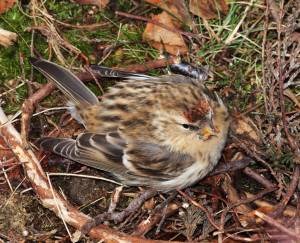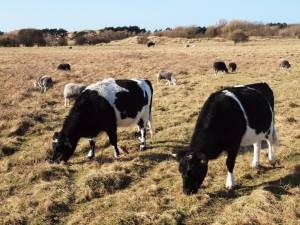February used to be known as “fill-dyke”, the term originating in an old county rhyme:
“February fill the dyke,
Be it black or be it white;
But if it be white;
It’s better to like”
For the first time in several years, the month lived up to its reputation. Rain fell on about 18 days and, though rarely heavy, its total was enough to raise the dune water-table to a normal late-winter level. Many ponds on Freshfield Dune Heath were brim full by the month’s end, auguring well for dragonflies and water-plants later in the year. I visited the dune heath mainly to see the excellent scrub-clearance work by the hard-working volunteers. While there, I was surprised to find a Redpoll on the ground, missing some wing and tail feathers and apparently unable to fly, though still able to run away from me and hide under a pile of brushwood.

For the first time in several years, the month lived up to its reputation. Rain fell on about 18 days and, though rarely heavy, its total was enough to raise the dune water-table to a normal late-winter level. Many ponds on Freshfield Dune Heath were brim full by the month’s end, auguring well for dragonflies and water-plants later in the year. I visited the dune heath mainly to see the excellent scrub-clearance work by the hard-working volunteers. While there, I was surprised to find a Redpoll on the ground, missing some wing and tail feathers and apparently unable to fly, though still able to run away from me and hide under a pile of brushwood.
To help our Natterjack Toads in dune areas where surface water is in short supply, a dozen or so new scrapes have been excavated at Altcar Rifle Range, Lifeboat Road and on the National Trust estate. Funded by the Million Ponds and Landscape Partnership projects, these shallow pools with their sandy surrounds should make ideal breeding sites.
The North Merseyside Amphibian & Reptile Group organised a management task on 6th when I joined seven volunteers at Cabin Hill frontal dunes to create bare sand patches in the dense Marram on south-facing slopes. Here, the proportion of open sand has declined from about 40% in the 1960s to less than 5% now. Although mainly for Sand Lizards this work will also benefit rare insects and plants. While catching our breath, we were entertained by huge swirling flocks of waders being pushed up the beach by the high-tide. They were even attacked by a Peregrine, which caught a Knot in mid-air before eating it on the shore. The winter shore-bird counts here averaged 77,000, the highest figures ever for this part of the Sefton Coast. While a majority of the birds were Knot, there were also spectacular numbers of Bar-tailed Godwits, Dunlins, Grey Plovers and Sanderlings.
I took two old University friends from Sussex to see the waders on 23rd. They were mightily impressed, especially when, on cue, the Peregrine turned up again for its customary snack and another Knot met an unfortunate end. They were also interested to see historical features, such as the steps of the old Formby Promenade and the Black Poplars planted over 100 years ago. We also visited the spectacular Devil’s Hole blow-out, the floor of which was beginning to flood, though not yet up to the levels of 2008.
The Herdwick Sheep on the nearby Cabin Hill reserve have now been joined by five Shetland Cattle. This small versatile breed, much used elsewhere for conservation grazing, is noted for its hardiness and ability to thrive on a variety of forage. As was hoped, the cows seemed to spend a lot of their time browsing willow and Sycamore scrub.

Pink-footed Goose numbers on the mosses were lower than usual in February; however, on 17th near Sniggery Farm, I found a flock of 1000 that included two Greylags, while about 3000 Pinkfeet at Plex Moss on 22nd contained three Barnacle Geese.
The approaching spring was heralded by the first returning Avocets at Martin Mere on 13th, while Snowdrops were plentiful from the middle of the month. I was also pleased to find a wonderful display of colourful Early Crocus at Kenilworth Road dunes, Ainsdale on 24th. Despite being garden-escapes, these flowers raise the spirits at this time of year.
